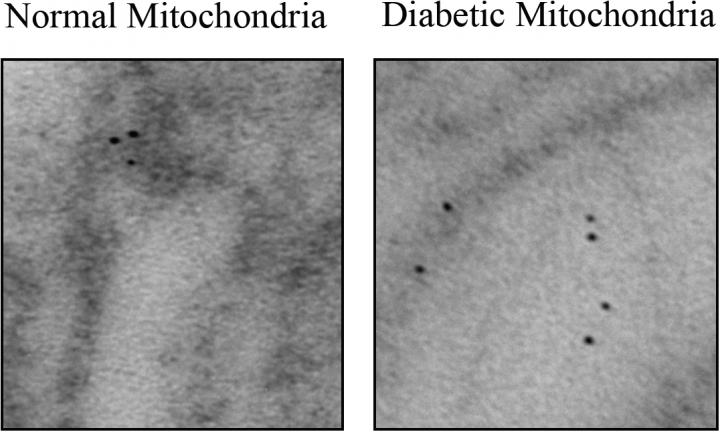Molecular link found between high glucose, metabolic disease

An electron microscope image shows dark-stained O-GlcNAc transferase localized to one complex in the mitochondrial membrane, left, and scattered to the inside of the mitochondria, right. Credit: Partha Banerjee/Johns Hopkins Medicine
“Sugar itself isn't toxic, so it's been a mystery why high blood sugar can have such a profound effect on the body,” says Gerald Hart, Ph.D. , director of the Johns Hopkins University School of Medicine's Department of Biological Chemistry. “The answer seems to be that high blood sugar disrupts the activity of a molecule that is involved in numerous processes within the cell.”
Previous experiments by other research groups had shown that the high blood sugar of untreated diabetes alters the activity of mitochondria, compartments that process nutrients into useable energy for cells.
To find out why, postdoctoral fellow Partha Banerjee, Ph.D., compared the enzymes in mitochondria from the hearts of rats with diabetes to those from healthy rat hearts. He looked for differences in levels of two enzymes that add and remove a molecule called O-GlcNAc to proteins. Hart's research group has for 30 years studied cells' use of O-GlcNAc to control how nutrients and energy are processed.
Banerjee found that levels of one enzyme, O-GlcNAc transferase, that adds O-GlcNAc to proteins was higher in the diabetic rat mitochondria, while levels of an enzyme that removes O-GlcNAc, O-
“We expected the enzyme levels to be different in diabetes, but we didn't expect the large difference we saw,” Banerjee says. He and his colleagues say they also found that the location of one of the enzymes within the mitochondria was different in the diabetic mice.
Producing energy requires an intricate interplay between enzyme complexes embedded in mitochondrial membranes, each with a distinctive role. O-GlcNAc transferase is normally found in one of these complexes, but in the diabetic mice, much of it had migrated to the inside of the mitochondria, Banerjee says.
The net effect of the changes in O-GlcNAc-related activity, Hart says, is to make energy production in the mitochondria less efficient so that the mitochondria begin to produce more heat and damaging molecules as byproducts of the process. The liver then kicks off an antioxidant process for neutralizing so-called free radicals, which involves making more glucose, increasing blood sugar further.
Finding a medication that normalizes activity of the O-GlcNAc enzymes, he says, could be an effective way to prevent or treat diabetes.
###
Junfeng Ma of The Johns Hopkins University was also an author on the paper.
Hart receives a share of royalty received by the university on sales of the CTD 110.6 antibody, which are managed by The Johns Hopkins University. CTD 110.6 antibody was used in the experiments described here.
Media Contact
All latest news from the category: Life Sciences and Chemistry
Articles and reports from the Life Sciences and chemistry area deal with applied and basic research into modern biology, chemistry and human medicine.
Valuable information can be found on a range of life sciences fields including bacteriology, biochemistry, bionics, bioinformatics, biophysics, biotechnology, genetics, geobotany, human biology, marine biology, microbiology, molecular biology, cellular biology, zoology, bioinorganic chemistry, microchemistry and environmental chemistry.
Newest articles

A universal framework for spatial biology
SpatialData is a freely accessible tool to unify and integrate data from different omics technologies accounting for spatial information, which can provide holistic insights into health and disease. Biological processes…

How complex biological processes arise
A $20 million grant from the U.S. National Science Foundation (NSF) will support the establishment and operation of the National Synthesis Center for Emergence in the Molecular and Cellular Sciences (NCEMS) at…

Airborne single-photon lidar system achieves high-resolution 3D imaging
Compact, low-power system opens doors for photon-efficient drone and satellite-based environmental monitoring and mapping. Researchers have developed a compact and lightweight single-photon airborne lidar system that can acquire high-resolution 3D…





















